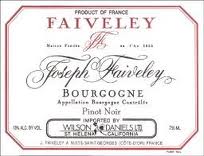A wine I had with dinner last week, 2008 Faiveley Bourgogne Rouge (about $20), reminded me of the perils of assessing young wines. I tasted this wine, along with many other 2008 red Burgundies several times, from barrel and shortly after they were bottled. My overriding impression was that the 2008 reds were lean and acidic.
What a difference time in the bottle makes! And not just for this wine. Certainly, Faiveley’s “simple” Bourgogne Rouge has filled out and become beautifully balanced. The raging acidity that was so apparent two years ago now is balanced by engaging ripe fruit, spice and earthiness.
 I have no idea where all that fruit was hiding two years ago. I’ve had the same experience with plenty of other 2008 red Burgundies, such as those from Drouhin. To be sure, not all of the 2008s have developed into balanced wines, which reinforces the need to get good advice from those you trust before buying them.
I have no idea where all that fruit was hiding two years ago. I’ve had the same experience with plenty of other 2008 red Burgundies, such as those from Drouhin. To be sure, not all of the 2008s have developed into balanced wines, which reinforces the need to get good advice from those you trust before buying them.
Part of the transformation of the Faiveley’s 2008 Bourgogne was undoubtedly due to the recent changes at this 185-year old family run winery. In 2007 Erwan Faiveley took the reins from his father, Francois, and brought in Bernard Hervet, who had previously orchestrated the rejuvenation of Bouchard Père et Fils a decade earlier.
Hervet and his team’s work allowed Bouchard Père et Fils to reclaim its position in the top tier of Burgundy négociants. It’s deja vu all over again. Almost immediately after Erwan’s new team was in place, Faiveley’s red wines acquired a silky suppleness in place of their dry tannic edge.
Martin Sinkoff, Director of Marketing – Fine Wines for Frederick Wildman, Faiveley’s US importer, says that Faiveley’s transformation is not complete. They are moving toward separating their négociant business entirely from their domaine wines. As part of refocusing, they are considering establishing a separate domaine with its own winery and label for their wines from Mercurey and the rest of the less prestigious Côte Chalonnaise to distinguish them from their Côte d’Or wines, which would be the only ones to carry the Domaine Faiveley label.
Even without changes in the winemaking team, the trajectory of young wines can be unpredictable. It is most apparent with Burgundy in what winemakers refer to as “difficult vintages,” such as 2008. So far, at least, there have been few surprises with how the red Burgundies from 1999 or 2005, two great years, are evolving. But surprises occur with most wines. As I noted in last week’s blog, the 2007 Ornellaia blossomed into a magnificent wine in the one year since its release. And with a decade of age, critics are reevaluating the virtues of the 2001 vintage in Bordeaux compared to the more hyped 2000.
So when you hear sweeping pronouncements about vintages, remember, evaluating young wines can be like predicting how a movie will end by watching just one scene.
2
